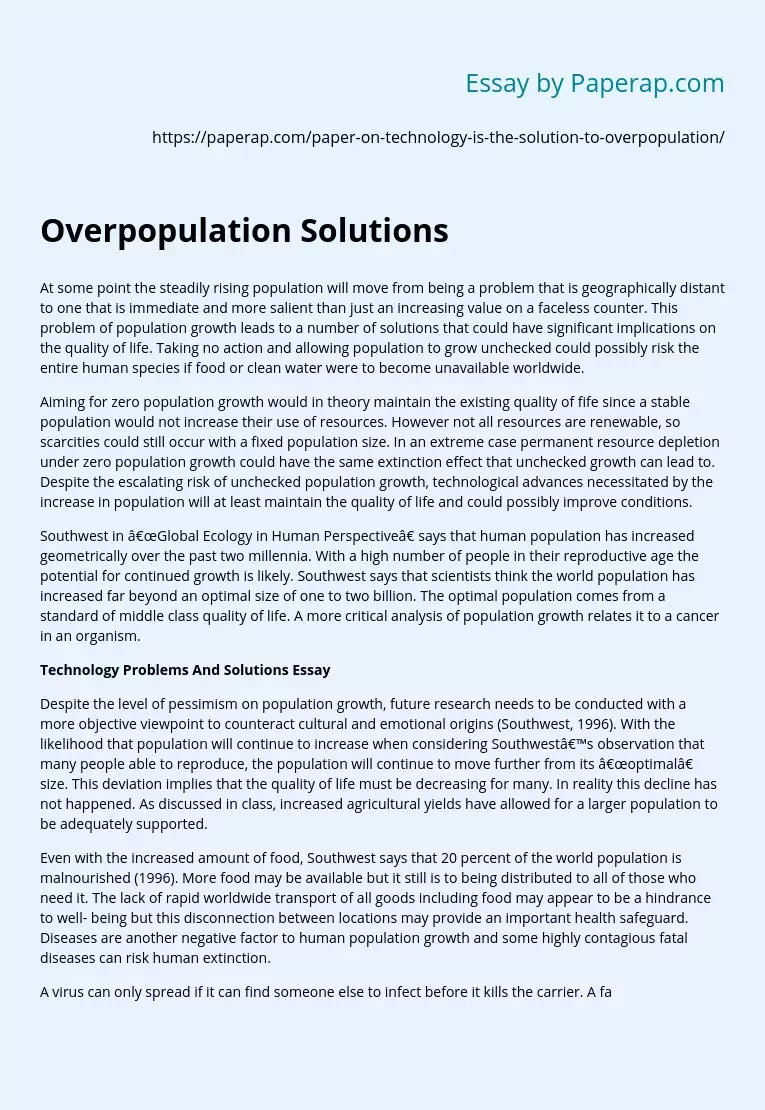Technology Problems And Solutions Essay
At some point the steadily rising population will move from being a problem that is geographically distant to one that is immediate and more salient than just an increasing value on a faceless counter. This problem of population growth leads to a number of solutions that could have significant implications on the quality of life. Taking no action and allowing population to grow unchecked could possibly risk the entire human species if food or clean water were to become unavailable worldwide.
Aiming for zero population growth would in theory maintain the existing quality of fife since a stable population would not increase their use of resources. However not all resources are renewable, so scarcities could still occur with a fixed population size. In an extreme case permanent resource depletion under zero population growth could have the same extinction effect that unchecked growth can lead to. Despite the escalating risk of unchecked population growth, technological advances necessitated by the increase in population will at least maintain the quality of life and could possibly improve conditions.
Southwest in “Global Ecology in Human Perspective” says that human population has increased geometrically over the past two millennia. With a high number of people in their reproductive age the potential for continued growth is likely. Southwest says that scientists think the world population has increased far beyond an optimal size of one to two billion. The optimal population comes from a standard of middle class quality of life. A more critical analysis of population growth relates it to a cancer in an organism.
Despite the level of pessimism on population growth, future research needs to be conducted with a more objective viewpoint to counteract cultural and emotional origins (Southwest, 1996). With the likelihood that population will continue to increase when considering Southwest’s observation that many people able to reproduce, the population will continue to move further from its “optimal” size. This deviation implies that the quality of life must be decreasing for many. In reality this decline has not happened. As discussed in class, increased agricultural yields have allowed for a larger population to be adequately supported.
Even with the increased amount of food, Southwest says that 20 percent of the world population is malnourished (1996). More food may be available but it still is to being distributed to all of those who need it. The lack of rapid worldwide transport of all goods including food may appear to be a hindrance to well- being but this disconnection between locations may provide an important health safeguard. Diseases are another negative factor to human population growth and some highly contagious fatal diseases can risk human extinction.
A virus can only spread if it can find someone else to infect before it kills the carrier. A fatal disease that leads to death after a long period of time increases the chance that the carrier can infect other people, in turn bringing population closer to extinction. In terms Of transportation, if people and goods in the world are too well connected, then a fatal disease that has the potential to lead to extinction would be able to infect many people over large area since the disease can spread quickly over trade routes.
The World Health Organization has found that the current spread of Severe Acute Respiratory Syndrome or CARS is facilitated by international travel and can quickly infect many people around the world. Originating in Southeast Asia, speedy transportation has turned CARS from a regional problem into an international issue (World Health Organization, 2003). To avoid the risk of mass deaths due to rapidly spreading diseases, international policymakers need to avoid the creation off level of world interconnectedness that is too quick.
A slightly disconnected world may mean goods may not reach all places where in demand, but the risk of fatal diseases affecting large regions of population would be less. The ideal model of resource distribution is to have necessities be located near areas of population. Localized resources would reduce the need for goods to travel long distances over a lengthened period of time to avoid the spread of disease. Increased levels of population could live well off of added amounts of food that are nearby.
This best case of locating populations near resources would be difficult to obtain in practice as resources and populations are already in fixed locations. If people were unwilling to move near where food is available it would be difficult, except in times Of war and famine, to force them to relocate. A compromise solution would accept the fact that not all people of the world will be able to have a high standard of living but the potential for improved quality exists. This potential cannot be reached immediately since resources ND population remain geographically separate and faster transportation would increase the spread of fatal diseases.
Technology Problems And Solutions Essay. (2019, Dec 05). Retrieved from https://paperap.com/paper-on-technology-is-the-solution-to-overpopulation/

